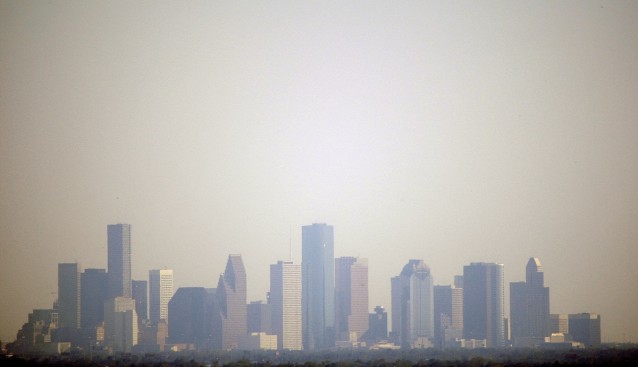"Texas’ Top Toxicologist: EPA’s New Smog Regulations Unnecessary, Just Stay Indoors"

Downtown Houston in October, 2008. The city has severe smog issues and new research suggests that pollution from fracking contributes significantly to the problem.
CREDIT: AP/David J. Phillip
Texas’ chief toxicologist is arguing that the EPA shouldn’t tighten ground-level ozone, or smog, rules because there will be little to no public health benefit. Dr. Michael Honeycutt heads the toxicology division of the Texas Commission on Environmental Quality (TCEQ), the state agency tasked with protecting Texans from pollution.
“Ozone is an outdoor air pollutant because systems such as air conditioning remove it from indoor air,” he argues on a blog post on the TCEQ website. “Since most people spend more than 90 percent of their time indoors, we are rarely exposed to significant levels of ozone.” He adds that those who are “near death” and thus more vulnerable to ozone spend even more time inside.
The overwhelming majority of scientists believe that the EPA should tighten ozone restrictions — as the agency is widely expected to do before December. In 2008 the EPA set the current ozone standard at 75 parts per billion (ppb). In June 2014, the EPA’s Clean Air Scientific Advisory Committee (CASAC) unanimously recommended that the agency lower the limit of ozone pollution from its current standard to between 60 and 70 ppb. A federal judge ruled that the agency needs to produce a draft of new, more stringent ozone regulations by December.
The CASAC group of scientists, physicians, researchers and air pollution experts said in their recommendation that they found scientific justification to call into question the adequacy of the current standard and that there is clear scientific support for the need for revision.
Dr. Honeycutt has taken it upon his shoulders to dispute this determination. He joins Texas Republicans and others nationwide who staunchly oppose efforts to reduce harmful ozone pollution. In September, a group of Texas Republicans proposed legislation that would require Congress to pass a federal statute every time the EPA wants to implement a National Ambient Air Quality Standard (NAAQS) such as the one proposed for ozone pollution. They argue that this is a matter of accountability, but it is within the EPA’s mandate to determine air quality standards. In a statement, Congressman Randy Weber (R-TX), cites a study from the National Association of Manufacturers (NAM) that the regulation would increase energy costs for Texas families and reduce family incomes in an amount equal to 182,000 lost jobs.
NAM is a trade group which lobbies for the likes of ExxonMobil and the American Petroleum Institute. NYU’s Michael Livermore, a senior advisor at New York University’s Institute for Policy Integrity told Media Matters that the report “calculated costs in an insane way.” Frank Ackerman, a lecturer in climate and energy policy at the Massachusetts Institute of Technology told Media Matters that the job-loss estimates are “fraudulent.”
In his blog post, Honeycutt cites the NAM study to say that the ozone standards could constrain natural gas production and cause electricity prices to rise by 15 percent for residential customers and 23 percent for industrial customers. Toxicologists are usually concerned with the public health costs of the pollutants — not the industry’s prediction regarding the costs of regulation.
As of July, 123 million people — 40 percent of the U.S. population — lived in areas that don’t meet the current ozone standards, primarily in urban and industrial settings. These people are at risk for premature death, aggravated asthma, difficulty breathing, cardiovascular harm and lower birth weight, according to the American Lung Association, which states the the actual number who breathe unhealthy levels of ozone is likely much larger, since this number does not include people who live in adjacent counties in metropolitan areas where no monitors exist. Ground-level ozone is a product of reactions of various gases from fossil fuel burning when exposed to sunlight. Ozone concentrations can reach unhealthful levels when the weather is hot and sunny with little or no wind, according to the EPA.
While ozone is a complex pollutant that is challenging to measure, Honeycutt sees the tree rather than the forest in his argument against tightening regulations. He focuses on the slight increase in premature deaths that could result if ozone standards are lowered — due to the fact that lowering levels of nitrogen oxide can temporarily increase ozone levels because nitrogen also helps dissipate ozone.
Models do predict a slight increase in premature deaths at first, Elena Craft, a senior health scientist at the Environmental Defense Fund told the Texas Tribune. She compared it to research saying that smokers have an increased risk of lung cancer right after quitting smoking.
“That doesn’t mean that you don’t quit smoking,” Craft said. The premature death prediction “does not mean pollution is good for you. It means that you need to double down on the efforts to reduce emissions in the air.”
Honeycutt seems to be following Texas Republican gubernatorial candidate Greg Abbott’s lead instead by doubling down on attacking the EPA — which he says is the “the right thing to do” on his blog. As state Attorney General, Abbott sued the EPA at least 17 times. However when it comes to ozone restrictions, this is already a losing battle. In 2001 the Supreme Court struck down a challenge to EPA regulations that included the ozone standard. Then earlier this month, the Supreme Court declined to hear a business group’s claim that the 2008 rules for ozone are too strict.
Recent research suggests that in Texas the proliferation of shale gas drilling and expansion of refineries and plants has contributed significantly to an increase in ozone levels, especially in places with heavy oil and gas activity.







 FRONT
FRONT